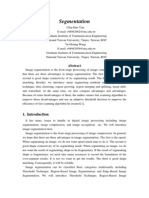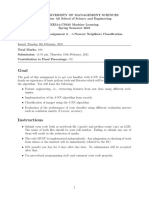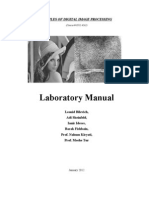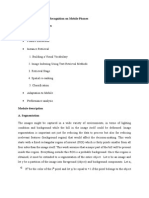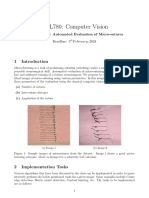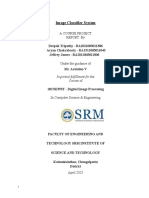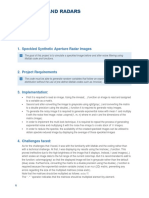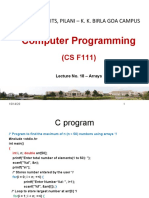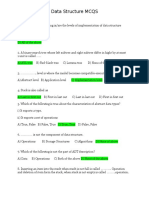Dip Lab - 9
Dip Lab - 9
Uploaded by
Golam DaiyanCopyright:
Available Formats
Dip Lab - 9
Dip Lab - 9
Uploaded by
Golam DaiyanOriginal Description:
Original Title
Copyright
Available Formats
Share this document
Did you find this document useful?
Is this content inappropriate?
Copyright:
Available Formats
Dip Lab - 9
Dip Lab - 9
Uploaded by
Golam DaiyanCopyright:
Available Formats
CEN 440 Digital Image Processing
Implementation of cluster based segmentation of an image
Lab 9
Name: _________________________________
Enrollment #: _________________________________
Class: _________________________________
Objective
Today’s lab covers segmentation of images into regions. We will be specifically focusing on
segmentation based on clustering using the classical k-means clustering algorithm. By the end of
this lab you should be able to implement cluster based segmentation of an image.
Submission Requirements
You are expected to complete the assigned tasks within the lab session and show them to the
lab engineer/instructor. Get the lab journal signed by your instructor and submit it by the end of
lab session.
Tasks
Segmentation divides an image into disjoint regions such that pixels within a region share some
common attributes. Segmentation algorithms are broadly categorized into similarity and
discontinuity based methods. Similarity based segmentation exploits the key idea that pixels
within a region are ‘similar’ to one another. Discontinuity based methods, on the other hand,
rely on finding object boundaries and edges to identify different regions in an image.
A common approach in similarity based segmentation is to cluster similar pixels into groups
using standard clustering algorithms. The most commonly used of these clustering algorithms is
the k-mean clustering where given the number of clusters k, the algorithm iteratively partitions
the given data into k groups or clusters. In case of images, each pixel can be represented as a
point in a three dimensional space. The clustering algorithm can then be applied to identify
Digital Image Processing Page 1
Lab Journal – Lab 9
clusters of pixels in the color space and producing k distinct regions. Figure 1 illustrates an
example of applying k-mean algorithm to an image.
Figure 1 An image segmented into three clusters
The statistics tool box in Matlab provides the kmeans function to cluster data into k groups. The
function requires the data matrix and number of clusters as input and returns the index (cluster
number) of each data member. In case of colored images, we can extract the individual
channels of the image and create the data matrix as follows.
dataMatrix=[R;G;B];
dataMatrix =double( dataMatrix');
Where R, G and B represent the red, green and blue channels of the image each represented as
a vector. The data matrix fed to the k-means functions requires each row to be one data point.
Hence, the size of data matrix is M x 3 where M is the total number of pixels in the image. The
function returns an Mx1 vector giving the cluster number to which each pixel belongs. Each
cluster can then be represented by a different color to represent a region/cluster.
Digital Image Processing Page 2
Lab Journal – Lab 9
Exercise 1
Load the image ‘onion.png’ and perform color based segmentation using k-means
clustering. Provide k = 5 and represent each cluster by a different color.
In addition to similarity based segmentaiton, discontinuities in the image can also be exploited
to segment objects. Convolution with filters based on image derivates can be used for this
purpose. These filters can be employed to detect points, edges and lines in an image. In the
following exercise, you will detect lines in a givn image using line detection masks.
Exercise 2
Load the provided image ‘field.png’ and perform convolution with the four line detection
masks. Display the four output images to see the response of each filter on the image.
Do Exercises 1 and 2 and get them checked by your instructor. If you are unable to complete the
tasks in the lab session, deposit this sheet alongwith your programs (printed or handwritten)
before the start of the next lab session.
S No. Exercise Checked By:
1. Exercise 1
2. Exercise 2
+++++++++++++++++++++++++++
Digital Image Processing Page 3
Powered by TCPDF (www.tcpdf.org)
You might also like
- KNN AssignmentDocument4 pagesKNN AssignmentIrfan HussainNo ratings yet
- Ipmv Viva QuestionsDocument27 pagesIpmv Viva Questionssniper x4848 PillaiNo ratings yet
- Lab 1 Image - ProcessingDocument8 pagesLab 1 Image - Processinghassinehanane123No ratings yet
- DIP Lab FileDocument13 pagesDIP Lab FileAniket Kumar 10No ratings yet
- SegmentationDocument31 pagesSegmentationa7asharathNo ratings yet
- BDU - Document - Dominant Color in An Image Using KDocument46 pagesBDU - Document - Dominant Color in An Image Using Kthalaaskar55No ratings yet
- CENG 3264: Engin Des and Project MGMT - Lab 3 Matlab Tutorial II - Image ProcessingDocument5 pagesCENG 3264: Engin Des and Project MGMT - Lab 3 Matlab Tutorial II - Image Processinggopika hariNo ratings yet
- Assignment 02Document5 pagesAssignment 02Muhammad HusnainNo ratings yet
- Lab ManualDocument22 pagesLab ManualCiTiZeNGSNo ratings yet
- AdvancedSensorySystems Exercise 11Document5 pagesAdvancedSensorySystems Exercise 11Ogulcan KertmenNo ratings yet
- Lab 2: Introduction To Image Processing: 1. GoalsDocument4 pagesLab 2: Introduction To Image Processing: 1. GoalsDoan Thanh ThienNo ratings yet
- Lab Manual Image ProcessingDocument28 pagesLab Manual Image ProcessingVinita ChoudharyNo ratings yet
- NB2121 Practical 5 ExercisesDocument7 pagesNB2121 Practical 5 ExercisesRushan TanNo ratings yet
- Optical Character Recognition Using Neural Networks (ECE 539 Project Report)Document15 pagesOptical Character Recognition Using Neural Networks (ECE 539 Project Report)Rohit RajNo ratings yet
- Numpy TutorialDocument9 pagesNumpy TutorialYuan LeeNo ratings yet
- ACFrOgCfX9ATrHm9ZSjs1HLKnJCXmmPcIwFi Y7hVAv6zU1Li3igjIXOOLtGhffODBql8a993YAsc3gM SE8bidlMJr2eFkl9eJB0BU8jcLD6iWrroxwbp1 X9yQtpQks6r8vMLEnR-ORk02lgVJDocument20 pagesACFrOgCfX9ATrHm9ZSjs1HLKnJCXmmPcIwFi Y7hVAv6zU1Li3igjIXOOLtGhffODBql8a993YAsc3gM SE8bidlMJr2eFkl9eJB0BU8jcLD6iWrroxwbp1 X9yQtpQks6r8vMLEnR-ORk02lgVJHii ThereNo ratings yet
- Laboratory 1: DIP Spring 2015: Introduction To The MATLAB Image Processing ToolboxDocument7 pagesLaboratory 1: DIP Spring 2015: Introduction To The MATLAB Image Processing ToolboxAshish Rg KanchiNo ratings yet
- Assignment 3 BDocument7 pagesAssignment 3 Bsahilmukund.awasarkarNo ratings yet
- Project Report: Optical Character Recognition Using Artificial Neural NetworkDocument9 pagesProject Report: Optical Character Recognition Using Artificial Neural NetworkRichard JamesNo ratings yet
- CV Lab 12 - Implementatin of a Simple CNNDocument9 pagesCV Lab 12 - Implementatin of a Simple CNNHashaam ZafarNo ratings yet
- Lab 1 - Basics of Image ProcessingDocument10 pagesLab 1 - Basics of Image ProcessingsusareshNo ratings yet
- Image Classification Using CNN: Page - 1Document13 pagesImage Classification Using CNN: Page - 1BhanuprakashNo ratings yet
- Image Segmentation and Recognition Using MATLABDocument14 pagesImage Segmentation and Recognition Using MATLABPrafful SomaniNo ratings yet
- Understanding of Convolutional Neural Network (CNN) - Deep LearningDocument7 pagesUnderstanding of Convolutional Neural Network (CNN) - Deep LearningKashaf BakaliNo ratings yet
- Currency Recognition On Mobile Phones Proposed System ModulesDocument26 pagesCurrency Recognition On Mobile Phones Proposed System Moduleshab_dsNo ratings yet
- Deep Neural Network ApplicationDocument17 pagesDeep Neural Network Applicationsvenmarshall606No ratings yet
- DM-Ass03Document5 pagesDM-Ass03i200847 Fatima AsimNo ratings yet
- Character Recognition Using Neural Networks: Rókus Arnold, Póth MiklósDocument4 pagesCharacter Recognition Using Neural Networks: Rókus Arnold, Póth MiklósSharath JagannathanNo ratings yet
- Col780 A1Document4 pagesCol780 A1Hemant SinghNo ratings yet
- Image Super Resolution ReportDocument12 pagesImage Super Resolution ReportNikhil GuptaNo ratings yet
- DogCat ReportDocument10 pagesDogCat ReportBulat SuleymanovNo ratings yet
- ROBT205-Lab 06 PDFDocument14 pagesROBT205-Lab 06 PDFrightheartedNo ratings yet
- CS7643: Deep Learning Assignment 3: Instructor: Zsolt Kira Deadline: 11:59pm Mar 14, 2021, ESTDocument12 pagesCS7643: Deep Learning Assignment 3: Instructor: Zsolt Kira Deadline: 11:59pm Mar 14, 2021, ESTKev LaiNo ratings yet
- M Shahab 1710305075121Document21 pagesM Shahab 1710305075121Mushahid Hussain NomeeNo ratings yet
- 20 Questions To Test Your Skills On CNN Convolutional Neural NetworksDocument11 pages20 Questions To Test Your Skills On CNN Convolutional Neural NetworksKumkumo Kussia KossaNo ratings yet
- Practical 3Document4 pagesPractical 3magnusNo ratings yet
- Programming Assignment 3 3D Reconstruction: InstructionsDocument15 pagesProgramming Assignment 3 3D Reconstruction: InstructionsHilbert JeffNo ratings yet
- MIC Assignment4Document9 pagesMIC Assignment4pt.salwabatoolNo ratings yet
- Evaluating The Performance of Content-Based Image Retrieval SystemsDocument12 pagesEvaluating The Performance of Content-Based Image Retrieval SystemsLuke WalkerNo ratings yet
- Convolution Neural Networks U2Document24 pagesConvolution Neural Networks U2vijayganesh.s.2022.adsNo ratings yet
- "I C U N N ": Mage Lassification Sing Eural EtworksDocument15 pages"I C U N N ": Mage Lassification Sing Eural Etworksbabloo veluvoluNo ratings yet
- Building A Convolutional Neural Network Using Tensorflow KerasDocument10 pagesBuilding A Convolutional Neural Network Using Tensorflow Kerasharshita.btech22No ratings yet
- Lab 3 DSPBEE13Document7 pagesLab 3 DSPBEE13MaryamNo ratings yet
- DIP Mini ProjectDocument12 pagesDIP Mini ProjectSHIVANSH KASHYAP (RA2011003010988)No ratings yet
- Lab 4Document3 pagesLab 4Kavin KarthiNo ratings yet
- Emotion Classification On Face Images: Stanford UniversityDocument6 pagesEmotion Classification On Face Images: Stanford UniversityHarshit MogalapalliNo ratings yet
- Merging Images Using Matlab: S.Triaška,-M.Gažo Institute of Control and Industrial InformaticsDocument5 pagesMerging Images Using Matlab: S.Triaška,-M.Gažo Institute of Control and Industrial InformaticsJoão PiresNo ratings yet
- Image RestorationDocument12 pagesImage RestorationHarikesh MauryaNo ratings yet
- DIP Lab-4Document5 pagesDIP Lab-4Golam DaiyanNo ratings yet
- Simulation Speckled Synthetic Aperture Radar Images After Noise Filtering Using MatLabDocument4 pagesSimulation Speckled Synthetic Aperture Radar Images After Noise Filtering Using MatLabMajed ImadNo ratings yet
- Deep Koalarization: Image Colorization Using Cnns and Inception-Resnet-V2Document12 pagesDeep Koalarization: Image Colorization Using Cnns and Inception-Resnet-V2Nitheesh ReddyNo ratings yet
- Assignment#3 AIDocument5 pagesAssignment#3 AITaimoor aliNo ratings yet
- Mini Project MaheshDocument17 pagesMini Project MaheshSai PrashanthNo ratings yet
- BME311 A - Laboratory Assignment 3Document6 pagesBME311 A - Laboratory Assignment 3Margret DequitoNo ratings yet
- 5ELEN019W Sensors and Interfaces Referral - Deferral Lab Assessment - 2023-24Document6 pages5ELEN019W Sensors and Interfaces Referral - Deferral Lab Assessment - 2023-24kazeemsodikisola1991No ratings yet
- Automated Neural Image Caption Generator For Visually Impaired PeopleDocument6 pagesAutomated Neural Image Caption Generator For Visually Impaired PeopleSagor SahaNo ratings yet
- AboutDocument5 pagesAboutI'Gede SuardikaNo ratings yet
- Paper 1 73Document6 pagesPaper 1 73Kavi Kumaresan JNo ratings yet
- DEEP LEARNING TECHNIQUES: CLUSTER ANALYSIS and PATTERN RECOGNITION with NEURAL NETWORKS. Examples with MATLABFrom EverandDEEP LEARNING TECHNIQUES: CLUSTER ANALYSIS and PATTERN RECOGNITION with NEURAL NETWORKS. Examples with MATLABNo ratings yet
- h1 Cse548 Spring2012Document4 pagesh1 Cse548 Spring2012stonethumbNo ratings yet
- 1 D Array Using Dynamic Memory Allocation AssignmentDocument4 pages1 D Array Using Dynamic Memory Allocation Assignment930 Sonawane ShrirangNo ratings yet
- Algorithm Design and Analysis (CS60007) Assignment 1: 1 Interval SchedulingDocument6 pagesAlgorithm Design and Analysis (CS60007) Assignment 1: 1 Interval SchedulingBraj SehraNo ratings yet
- CS301 P Lab ExercisesDocument77 pagesCS301 P Lab Exercisespirah chhachharNo ratings yet
- Binary Search Trees: Welcome To CS221: Programming & Data StructuresDocument37 pagesBinary Search Trees: Welcome To CS221: Programming & Data StructuresPRITAM RAJNo ratings yet
- Computer Science Project FileDocument23 pagesComputer Science Project Filekaushalmaurya738No ratings yet
- Question Paper Code:: (10×2 20 Marks)Document3 pagesQuestion Paper Code:: (10×2 20 Marks)rajkumarsac100% (2)
- Dynamicprogramming 160512234533Document30 pagesDynamicprogramming 160512234533Abishek joshuaNo ratings yet
- Algo122 Assignment2 JohnsonsAlgorithmDocument5 pagesAlgo122 Assignment2 JohnsonsAlgorithmkaushik81190No ratings yet
- Warshalls Floyds AlgorithmDocument12 pagesWarshalls Floyds AlgorithmPratiksha MuradeNo ratings yet
- Assignment SolutionDocument6 pagesAssignment SolutionODAA TUBENo ratings yet
- Online Placement RectangleDocument10 pagesOnline Placement RectangleNivedita Acharyya 2035No ratings yet
- Introduction To AI & ML QUESTION BANK MODULEWISEDocument3 pagesIntroduction To AI & ML QUESTION BANK MODULEWISEPRASHANTHNo ratings yet
- Data Structures & System Programming Lab FileDocument29 pagesData Structures & System Programming Lab FileCutie0% (1)
- B.Sc. Computer Science UG Syllabus SEPDocument11 pagesB.Sc. Computer Science UG Syllabus SEPMohammed yaseenNo ratings yet
- LP5 List of AssignmentsDocument2 pagesLP5 List of AssignmentskunalisatworkNo ratings yet
- CA 5 - Branch and BoundDocument6 pagesCA 5 - Branch and BoundMustafa FarragNo ratings yet
- Computer Programming: Bits, Pilani - K. K. Birla Goa CampusDocument15 pagesComputer Programming: Bits, Pilani - K. K. Birla Goa CampusAditya JabadeNo ratings yet
- Lecture 2.2.3 Operations On QueuesDocument14 pagesLecture 2.2.3 Operations On QueuesJosephNo ratings yet
- DS-NOTES-JNTUK-R23-UNIT-1Document14 pagesDS-NOTES-JNTUK-R23-UNIT-1sgec.csehod100% (1)
- Selection Sort AlgorithmDocument5 pagesSelection Sort AlgorithmhurramNo ratings yet
- Data Structure McqsDocument45 pagesData Structure McqsIhsanullah Khan100% (2)
- Assignment Problem 1: SUBMITTED BY:-Manish Kumar Div:-IB (A) Roll NO:-20MBAIB020Document14 pagesAssignment Problem 1: SUBMITTED BY:-Manish Kumar Div:-IB (A) Roll NO:-20MBAIB020Manish KumarNo ratings yet
- SE-FDS-Sample Questions For All UnitsDocument4 pagesSE-FDS-Sample Questions For All UnitssiddheshshaileshbhosaleNo ratings yet
- Data Structures in JavaDocument46 pagesData Structures in JavaMahesh Roy ChinnaNo ratings yet
- Data Structure and AlgorithmsDocument5 pagesData Structure and Algorithmssamir pramanik50% (2)
- Data Science Lab ExperimentsDocument32 pagesData Science Lab Experimentsganeshsrinivas196No ratings yet
- DAA Approximation AlgorithmsDocument32 pagesDAA Approximation AlgorithmsAnn thabithaNo ratings yet
- Programming, Data Structures and Algorithms Using Python: Course OutlineDocument1 pageProgramming, Data Structures and Algorithms Using Python: Course OutlineGanesh RNo ratings yet
- C ProgramsDocument54 pagesC ProgramsSai Sharath JammuNo ratings yet




